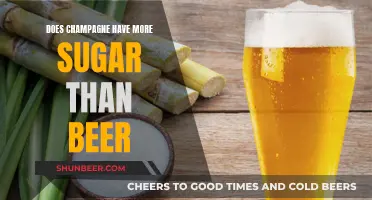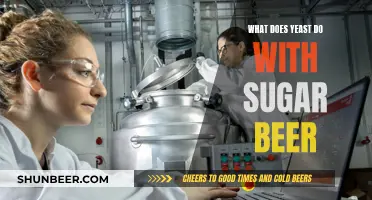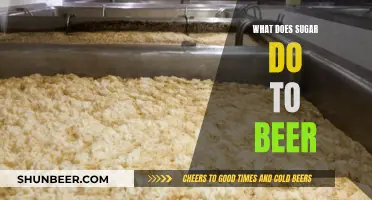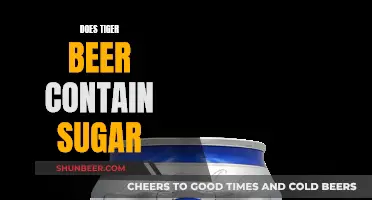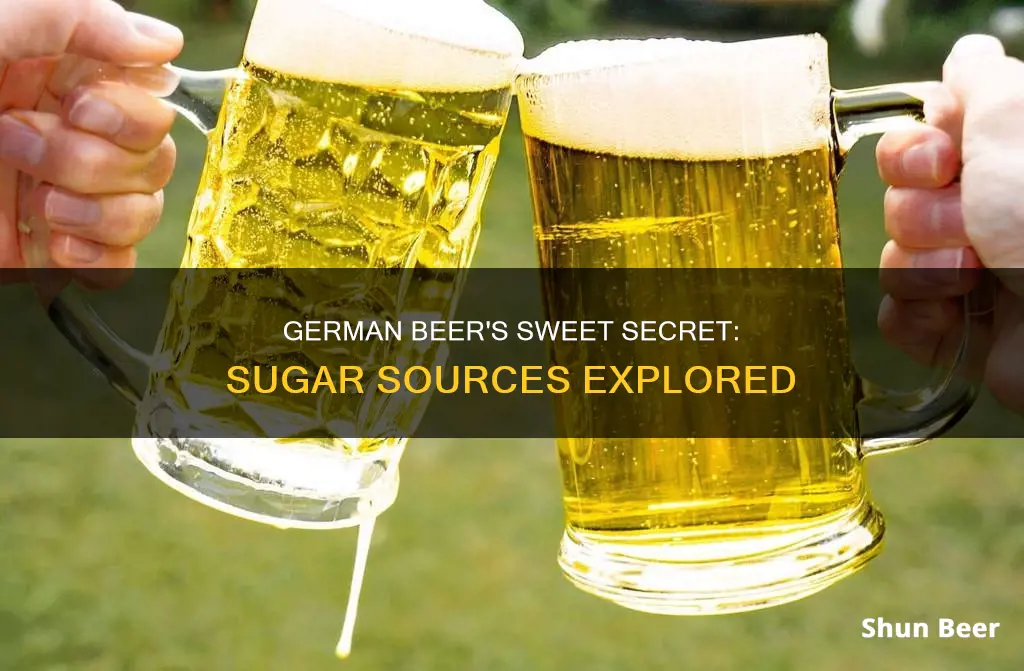
German beer is renowned worldwide, and the country's brewing traditions are steeped in history. So, what is the sugar source for German beer?
The answer lies in the country's famous brewing laws. The Bavarian Purity Law of 1516, or Reinheitsgebot, states that only hops, malt, and water may be used in the production of beer—not even yeast is mentioned! This means that the sugar source for German beer is primarily malted barley, which is processed to create fermentable sugars, mainly maltose.
While modern German brewers might use other sugar sources, such as corn sugar or rice syrup, for bottle priming or to adjust the flavour and body of the beer, the traditional approach adheres strictly to the Reinheitsgebot.
| Characteristics | Values |
|---|---|
| Main ingredients | Yeast, grains, spices, and water |
| Sugar source | Processing of grains |
| Sugar type | Maltose |
| Sugar content | 80% fermentable sugars and 20% oligosaccharides |
| Priming sugar | Corn sugar, table sugar, dry malt extract, demerara sugar, agave nectar, honey, treacle, maple syrup, molasses, and Belgian candi syrup |
What You'll Learn

German beer and the Reinheitsgebot
The Reinheitsgebot, or "purity order", is a series of regulations that limit the ingredients in beer in Germany and the states of the former Holy Roman Empire. The law was first introduced in Bavaria in 1516 by Duke Wilhelm IV, but similar regulations predate the Bavarian order. The original law limited ingredients to barley, hops, and water, and was intended to protect drinkers from high prices, ban the use of wheat in beer so that more bread could be made, and stop brewers from adding dubious toxic and even hallucinogenic ingredients.
The Reinheitsgebot is recognised as the first and best-known consumer protection law still enforced in Germany and probably the world. It is also considered the most famous law that regulates the brewing of beer, influencing brewing not only in Germany but around the world. The law has been amended over the years, and now states that malted grains, hops, water, and yeast may be used in beer—but nothing else.
The Reinheitsgebot has had an impact on the diversity of beer in Germany, forbidding the use of extenders such as rice, corn, sorghum, and other grains that are favoured by American brewers to give a lighter taste and cheaper brew. Some commentators, German brewers, and politicians have argued that the law has slowed Germany's adoption of beer trends from the rest of the world, such as Belgian lambics and American craft styles.
In 1987, the European Union ruled that the Reinheitsgebot was a restraint of trade, and Germany was forced to allow non-conforming beers to be sold in the country. However, German law still requires that German brewers adhere to the Reinheitsgebot for beers sold inside Germany, with even stricter restrictions imposed on breweries in Bavaria and Baden-Württemberg.
While sugar is not listed as an ingredient in the Reinheitsgebot, it is necessary to produce alcohol. Sugar comes from the processing of the grains and is then fermented by yeast to produce alcohol.
Sour Beers: High Sugar Content or Healthy Choice?
You may want to see also

Sugar sources for priming
Sugar sources play a crucial role in priming beer, providing the yeast with the necessary fuel to create carbonation and, ultimately, a refreshing, bubbly beverage. Here is an overview of the most common sugar sources used for priming and their unique characteristics:
Corn Sugar (Dextrose)
Corn sugar, or dextrose, is a popular choice among homebrewers for priming due to its high fermentability, low moisture content, and neutral flavour. It is typically sold in pre-measured bags of 5 ounces (142 grams), which is suitable for a standard 5-gallon (19-litre) batch of beer. Corn sugar contains about 9% water, which means only 91% of its mass contributes to carbonation calculations. When using corn sugar, it is recommended to use 3/4 cups (6 ounces or 113 grams) for every 5 gallons of beer.
Table Sugar (Sucrose)
Table sugar, also known as cane sugar or beet sugar, is a cost-effective and convenient option for priming as it is readily available in most kitchens. Unlike corn sugar, table sugar does not contain water, so you will need about 10% less by weight when priming. The standard measurement for table sugar is 2/3 cup (5.3 ounces or 150 grams) for every 5 gallons of beer. While some sources claim that table sugar can impart a "harsh" flavour, others argue that the amount used is too small to significantly impact the flavour.
Dry Malt Extract (DME)
Dry malt extract (DME) is another option for priming, although it is more expensive than the previous two options. DME requires additional calculations as you need to consider its fermentability, known as the limit of attenuation. This value is usually provided by the manufacturer and represents the amount of material in the DME that yeast can digest and convert during fermentation. The standard measurement for DME is 1 1/4 cups (181 grams) for every 5 gallons of beer.
Honey
Honey can be used for priming and adds subtle floral notes to the beer. It is a relatively expensive option and is typically used for specialty beers, such as holiday ales. Due to its high moisture content, you will need between 15% to 20% more honey compared to corn sugar. The amount of honey needed can vary depending on its density, composition, and viscosity, so it is important to calculate its specific gravity and make adjustments accordingly.
Other Alternatives
While corn sugar, table sugar, DME, and honey are the most commonly used priming sugars, there are several other alternatives worth considering. These include Belgian candi syrup, molasses, maple syrup, treacle, agave nectar, and demerara sugar. Each of these alternatives can impart unique flavours and characteristics to the finished beer.
Blue Moon Beer: Sugar Content and Nutritional Facts
You may want to see also

Corn sugar for priming
Corn sugar, also known as dextrose or priming sugar, is a classic sugar used in priming beer. It gives consistent carbonation without greatly affecting flavour. It is also very soluble and easy for the yeast to digest. It is the most widely available commercial priming sugar and can be obtained from any homebrew store. It is also the choice of sugar that should be used if you are new to home brewing and the bottle priming process.
Corn sugar can be used to prime or add fermentables to beer, wine, cider, or any other favourite imbibements. It tends to lighten the body and dry out beers, so it can be used to increase alcohol content in lighter-coloured beer styles such as cream ales, pale ales, and IPAs without adding to body or mouthfeel.
To use corn sugar for priming, it is recommended to boil about two cups of water and dissolve your sugar in it. Boiling ensures sanitation and allows you to use less water since you can dissolve more sugar in hot water than in cold. Then, pour it into your brew and mix it in. If there is still sediment at the bottom of your bucket, this could be difficult. You have to be careful not to stir the sediment back into your beer, while also stirring the sugar into it.
Beer and Sugar: What's the Connection?
You may want to see also

Table sugar for priming
Table sugar, or sucrose, is a popular choice for priming beer. It is a simple, cheap, and easily available option that can be used for priming any kind of beer as it does not add any flavour to the brew.
However, some brewers claim that table sugar produces inconsistent results and should be avoided. This is because table sugar is a disaccharide, meaning it is a two-cell sugar, whereas corn sugar is a monosaccharide. The yeast has to work harder to split the two-bond version, which can result in stressed and weak yeast that produces off-flavours.
For five gallons of beer, the recommended amount of table sugar is ⅔ cup (5.3 ounces, or 150 grams). However, it is important to note that the measurements for table sugar and corn sugar are different, so they should not be substituted for each other.
To prepare a priming solution, boil about two cups of water and dissolve your sugar in it. Pour it into your brew and mix it in. Be careful not to stir up any sediment at the bottom of your bucket. The swirling motion of the beer as it is put into the bottling bucket will be enough to mix the priming solution without introducing oxygen to the brew, which can cause problems with the flavour.
Sour Beer's Sweet Secret: Sugar Content Explored
You may want to see also

Other sugars for priming
Although corn sugar is the most widely available commercial priming sugar, there are other options for priming your beer. These include:
- Table sugar (sucrose & fructose) is the most basic of priming sugars. It is appealing due to its low cost and easy availability. Although many homebrewers use table sugar on a regular basis without any issues, other brewers often claim it produces inconsistent results and shouldn't be used.
- Dry malt extract (DME) is an unfermented wort that has been dried into powder form. It helps add flavour and body to the beer, and some brewers argue that it gives finer bubbles. However, priming with DME can take much longer than sugar.
- Honey is a good option for meads or honey wines. It is about 95% fermentable, typically consisting of 38% fructose, 30% glucose, 8% various disaccharides, and 3% unfermentable dextrins. Honey contains wild yeasts and bacteria, but its low water content—usually around 18%—keeps these microorganisms dormant.
- Maple syrup is produced in the Northeastern United States and Southeastern Canada. It is derived from the sap of the sugar maple tree, and it takes 35 to 40 gallons of sap to produce one gallon of syrup. It tends to be lost during primary fermentation, so it should be added after this stage to retain as much flavour as possible.
- Belgian candi sugar is made almost exclusively in Belgium. It is crystallized beet sugar, ranging from light to dark in colour, and is one of the secrets of the Belgian brewing industry.
- Golden syrup (invert sugar, cane sugar) is a syrup made by processing cane sugar so as to break the bond between sugar molecules, allowing a cleaner fermentation. It is useful for strong ales because it adds fermentables without influencing colour or flavour.
- Molasses is a strong, dark byproduct of the sugar refining process. It is often found in porters and occasionally in old ales, brown ales, and so forth. It is easy to overdo.
- Treacle is a special dark molasses, even richer and darker than regular molasses. It is best used in strong black ales, such as old ales and stouts.
- Rice syrup or solids have the same uses as corn sugar, and are also used as an adjunct in many American-style lagers.
- Brown sugar is processed white table sugar with a little molasses added back in. It is sometimes used in British and Scottish brewing, and is useful for priming where a richer butterscotch flavour is desired.
Natural Sugar in Beer: What's the Truth?
You may want to see also
Frequently asked questions
The sugar source for German beer is malted barley.
The malting process involves the partial sprouting and drying of the barley grain. This creates enzymes that convert starches into sugars.
The main type of sugar created from malted barley is maltose, which is a disaccharide made up of two glucose molecules.
German beers typically follow the Reinheitsgebot, or Bavarian Purity Law, which allows only water, barley, hops, and yeast as ingredients. However, some German beers may also use table sugar or corn sugar for priming, which is added to the beer after fermentation to create carbonation.


